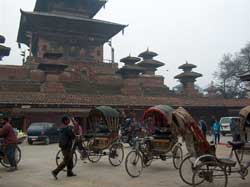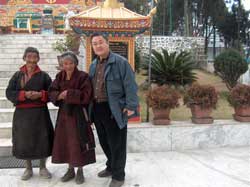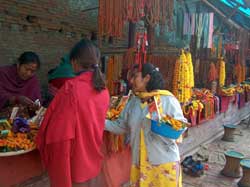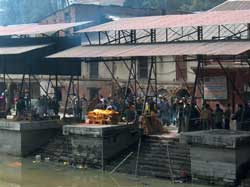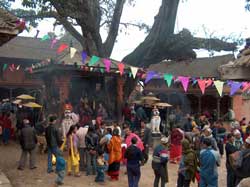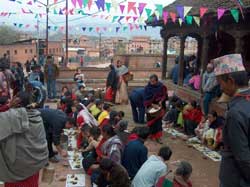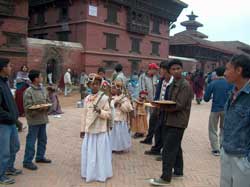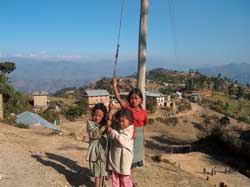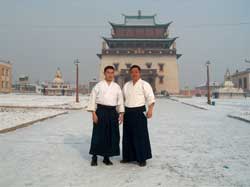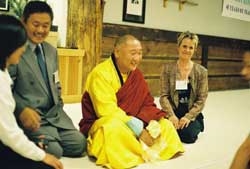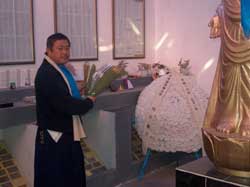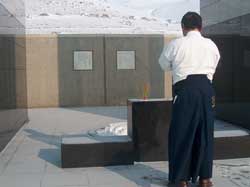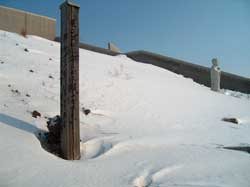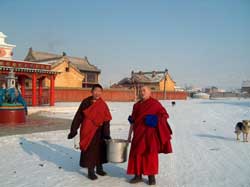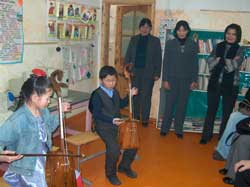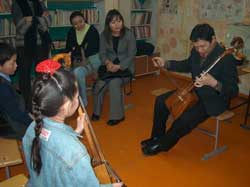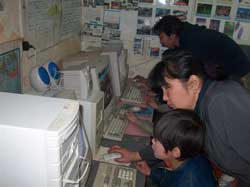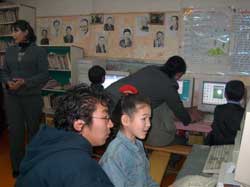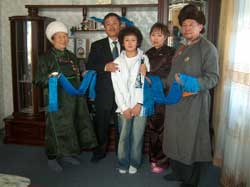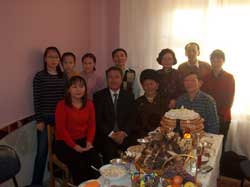Nepal Report
Written by
Nepal coordinator Puja Rai
After finishing up the busy New Year’s schedule of events at Nippon Kan headquarters in Denver, Homma Kancho took off for his first visit abroad for 2005. This trip was to take Homma Kancho to Nepal to do preliminary research for AHAN project development through Nippon Kan. The trip, January 26th-Feb 3rd, was coordinated by Nepal coordinator Puja, who lives in Kathmandu, Nepal.
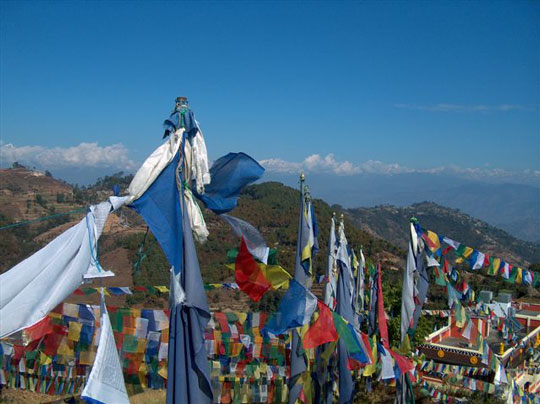
The Himalaya Mountains visible from the Nawa Buddha Temple.
Even though the trip from the US through Thailand to Nepal was a long one, Homma Kancho arrived in Kathmandu full of energy. The first stop was the hotel where Homma Kancho checked in before attending an activity meeting with local Nepalese staff. After the meeting Homma Kancho said that he had been instructed by friends from Nepal living in Denver to go to neighborhood temples to light candles and give donations in their honor. One of the most holy temples in Tibetian Buddhism is Nepal’s Boudhanath Pagoda where we stopped to light candles and pay respects.
The following day Homma Kancho began his research into environmental and social service support organizations in Nepal. He spent a great deal of time gathering information and talking to representatives from different Nepalese NGO organizations. (Non government organizations; the equivalent of non-profit organizations in the United States). Homma Kancho also met with instructors and organizers of martial art programs in Nepal, and was able to instruct one class for students involved with the military and police. Besides all of these activities we were able to visit Swayambhunath; Nepal’s oldst Tibetian Buddhist Temple, and Pashupatinath, Nepal’s largest Hindu Temple. We also found the time to visit the Nawa Buddhist temple about a two hour drive outside of Kathmandu.
Homma Kancho was not interested in the average souvenir shops in and around Kathmandu, but he was fascinated by the local markets. He made many trips to the markets by himself, venturing out by rickshaw to see the crafts and wares sold by local merchants. He also took the time to visit with the families of Nepalese friends back in Denver, delivering to them photos and letters from there loved ones so far away. Homma Kancho seemed to enjoy Nepalese home cooking, and particularly delighted in a homemade wine similar to Japanese sake called chang, and a distilled liquor similar to Japanese rice shochu called rakshi.
We were all surprised that Homma Kancho’s visit would be marked by a political coup, and we feared that he would not be able to leave as scheduled. All communication with the outside world was suspended and he was not able to communicate with his staff in Denver. I am sure they were very concerned for his safety, and luckily he made it out of Nepal on time without incident.
I enjoyed the time I spent with Homma Kancho and learned many things. I hope to continue my role as Nepal coordinator and help Nippon Kan and AHAN develop in Nepal in the future.
Homma Kancho has written a touching article about his experiences in Nepal titled “Prayers and Guns; a Report from Nepal.
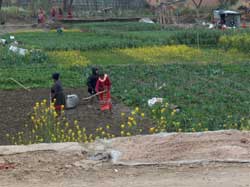
Mongolia Report
Written by Alimansar Nanmildorj
February 13th, 2005
My name is Alima, and I studied volunteer operations at Nippon Kan in Denver for about a one year period. Currently I am a Mongolian coordinator for Nippon Kan’s AHAN (Aikido Humanitarian Active Network) here in my home country of Mongolia, and serve as translator for Homma Kancho in Mongolian and Japanese. I would like to report on Homma Kancho’s visit to Mongolia this past February, 2005.
After leaving Nepal, Homma Kancho stopped over in Tokyo for one evening before continuing on to Mongolia. In Tokyo there was just enough time to arrange for a meeting of the Nippon Kan Japan staff to discuss support operations for various AHAN projects and also the Nippon Kan Japanese website.
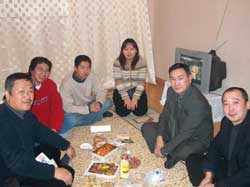
With AHAN Nippon Kan Mongolia
staff in Ulaanbaatar
I, Alimansar, Nippon Kan Mongolia staff coordinator, happened to be in Japan for a conference, and returned to Mongolia on the same flight as Homma Kancho. We arrived in Ulaanbaatar just before midnight. The temperature outside was -42 centigrade when we arrived. Nippon Kan Mongolia staff members Bold and Enk along with an entourage were waiting to greet Homma Kancho upon his arrival. Both of them had a coat, hat and gloves in hand for Homma Kancho who laughed, wondering how he was going to wear all of those clothes at the same time!
A Visit to Pay Respects at the Japanese Prisoners of War/Memorial Gravesite.
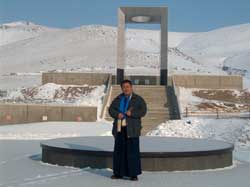
Homma Kancho at the Japanese
prisoner of war memorial.
The next morning, Homma Kancho began his visit to Mongolia with a tradition he has maintained over the past few years. We visited Gandan Temple, the largest Buddhist temple complex in Mongolia which is located in Ulaanbaatar. Last July 2004, the President of Mongolia, Bagabandi Natsag, visited Nippon Kan in Denver. In the President’s company was Choijamts Hamba Llama, the highest Buddhist Llama in Mongolia. On this visit to Gandan Temple, Homma Kancho was able to visit with Choijamts Hamba Llama who was at Gandan Temple to oversee the New Year ceremonies being performed there. Because he was in the midst of ceremonial prayer, there was no chance for a photo, but the two were able to spend a few warm moments together.
- At the Gandan Temple Aikido Nippon Kan Mongolia Instructor Bold Tumenjargl with Homma Kancho.
- Choijamts Hamba Llama visiting Nippon Kan in July 2004.
From the Gandan Temple in Ulaanbaatar, we headed north about 15 kilometers to the Damba-Darjaa Memorial. The memorial gravesite at Damba-Darjaa is dedicated to the Japanese prisoners of war who died in Mongolia after being held prisoner in Siberia during WW2. Homma Kancho brought white and yellow chrysanthemums as an offering of respect to these Japanese soldiers of so long ago that never made it back to their homeland.
- Damba-Darjaa Memorial Hall
- Paying respects.
- Buddha carved of stone near wooden memorial marker.
- Temple near the graveyard
In 1945-1947 at the end of WW2, Japanese prisoners of war that had been held in Siberia were moved to Mongolia. There were over 14,000 of these prisoners, of which 1,500 died in prison camps in different sites throughout Mongolia. In 2001, the remains of these prisoners were moved from various gravesites to this location at Damba-darjaa. At this new memorial, their remains were ceremoniously cremated and laid to rest together. The governments of Mongolia and Japan built this monument in their honor. Still today in Ullanbaatar there stands a building that was built by slave labor from the Japanese prisoner of war camps of WW2.
Visit to the Zorig Foundation.
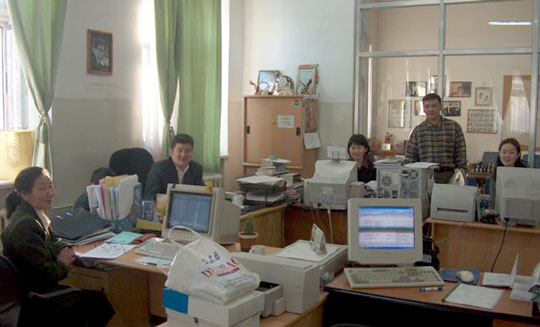
Zorig Foundation staff.
As a development in AHAN projects in Mongolia Homma Kancho went to visit Dr. Sanjursen Oyun of the Zorig Foundation whose office is located in the building housing the Mongolian Parliament. The Zorig Foudation was founder by Mr. Zorig who was a hero involved in the democratizing of Mongolia. On October 2, 1998 Mr. Zorig was assassinated, and his sister, Dr. Oyun took over the administration of the Zorig Foundation.
Today, the Zorig Foundation has grown to be one of the most outstanding humanitarian aid organizations in Mongolia, with sponsors in many countries including Japan and the United States.
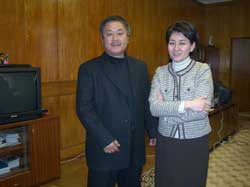
Homma Kancho with Dr. Sanjursen Oyun.
In December, Nippon Kan and AHAN shipped thirty computers to the Zorig Foundation in Mongolia to be distributed to Mongolian schools in need. This visit was a follow up check to see how the computers were distributed and to discuss plans for future shipments of computers and other related projects. At this meeting, Homma Kancho was able to explain the goals and scope of activities of AHAN to Dr. Oyun. The meeting ended with mutual thanks and a pledge from Dr. Oyun for future support of AHAN projects in Mongolia
Visit to the School Named Hope.
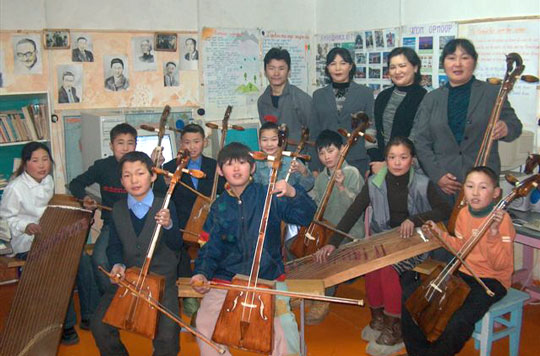
Children with Nippon Kan donated instruments. Can’t wait for the first concert!
All of the children gathered around in excitement as we arrived at the School named Hope. The School named Hope is located about a thirty minute drive from Ulaanbaatar in the town of Bayan Khoshuu. Today the school has ninety two students and is supervised by Principal Ayaya Sensei and four associate instructors.
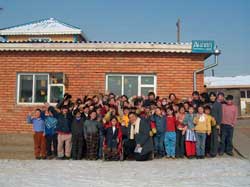
Homma Kancho with students.
In the late 1980’s, communism began its fall in Russia, and satellite countries such as Mongolia began to change as well. In 1992, the Peoples Republic of Mongolia officially became Mongolia; an independent and democratic country. This was a time of great transition of not only Mongolia’s politic systems but also its economic, educational and social systems underwent radial changes as well. Schools like the School named Hope are a product of these times of transition, and serve a special need in the greater Mongolian community.
With Mongolia’s new found freedom, free trade began and in many cases, people from the countryside came to Ulaanbaatar (Mongolia’s capital city) to find work. The families of these people came with them, and the children in these families needed to go to school.
In Mongolia, to move from one locality to another requires a residency permit. A residency permit allows for benefits, one of which is the acceptance of the children of permitted residents into publicly funded schools. Some people who come to “the big city” to work, cannot afford the proper permitting or are working only seasonally so their children are not allowed to attend public schools.
In China it is common for parents to leave their families behind in the countryside with other relatives while they seek work in other cities. Mongolia however is a country with a nomadic lifestyle and it impossible to leave the children behind to move with the herds as needed for grazing. In Mongolia, the entire family, (including the house at times), leave the countryside for the promise of a better future in Ulaanbaatar. If they have money, these new city residents can get the proper permitting and find an apartment to live in within the city. If there is no money, the family ger (traditional nomadic dwelling) is commonly set up outside the city limits to house the family while the parents would look for work.
The public school system in Mongolia with the help of the Mongolia government and international support from counties, most notably, Japan has been overhauled to meet more modern standards. The school buildings have been renovated, electrical and sewer systems replaced and educational tools and programs implemented. The government public school system has not been fully implemented everywhere in Mongolia however, and especially the children of nomadic workers have somewhat fallen through the cracks. The School named Hope is a special school that services the needs of these children of nomadic families. The School named Hope is a “private school” which has a much different reality than private schools have in the US. In Mongolia, the term private school means that government funding is not available, and the school must on private donations to survive; donations that fall short of meeting the needs of this organization as well as others.
The School named Hope became a target project for AHAN when Homma Sensei first visited the school in January of 2004. Since that time, AHAN and Nippon Kan has supported the school by supplying computers, school supplies, musical instruments to develop a traditional music program, sewing machines to teach vocational skills, electrical improvements and phone line installation.
The AHAN donated computers are now functioning at the school and maintenance and computer education programs are being overseen by AHAN Mongolia staff. The musical program is being supervised by nationally known morin huur (a traditional Mongolian string instrument) master craftsman Mr. Ulambayar. Mr. Ulambayar himself is a national treasure in Mongolia and his crafted instruments have been presented by the Mongolian government to the Queen of England.
Mr. Ulambayar volunteers his time to teach the children from the School named Hope their musical heritage with passion and dedication.
- Playing the Morin Huur.
- Mr. Ulambayar teaching the children.
Learning on the newly donated computers is supervised by
Nippon Kan AHAN Mongolian staff member, Enkbayar.
In recent years, the School named Hope has received support from the Zorig Foundation which has helped to improve the teaching conditions. This school may be poor; there is still only one biscuit and a cup of sautéed brown tea for the children’s lunch, but it is rich in human heart. The staff here is wonderful and very dedicated, and the children are bright, happy and ready to learn. Looking toward their own future and the future of their country, they study with enthusiasm. Two of the five teachers at this school have physical disabilities, which is still a severe barrier in Mongolia. This makes their dedication and talents just that much more admirable. We can all learn from them the results that dedication and sense of purpose can bring.
Dr. Ovun of the Zorig Foundation and members of the Mongolian Parliament are currently in the process of obtaining support for schools such as the School named Hope from UNICEF.
Just wait little children…more support from many parts of the world is on its way!
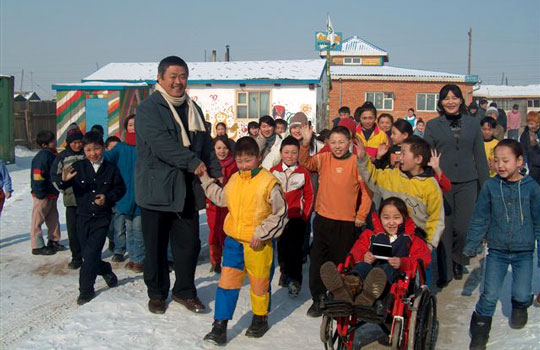
See you all again soon!
New Year in Mongolia; a Time for Paying Respects.
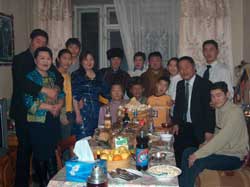
Nippon Kan Mongolia staff Bold Tumenjargl’s family home.
February 9th marks the New Year in Mongolia according the Tibetan Buddhist calendar. Following Mongolia custom and tradition, Homma Kancho dressed for the occasion and went home to home to visit families and friends in Ulaanbaatar. Between February 9th and 10th, we visited a total of seven family homes, each offering a feast of food and drink for the celebration.
Each visit does not consist of knocking on the door and saying “Happy New Year”, this would be totally inappropriate according to Mongolian custom. At the door, guests are greeted by the entire family. This greeting is followed by an exchange of small gifts or money tokens with the family householders accompanied by a special New Year arm to arm and cheek to cheek embrace and the salutation of “Omaraino”.
Guests are then escorted into the family home where they sit down together to drink chai (a lightly salted milk tea). Elders pass around snuff in beautifully adorned snuff bottles, and it is tradition to share in this ritual as well. The feast then begins with steaming lamb dumplings called buuz (pronounced boz) which arrive at the table piled high on serving plates. These dumplings are considered a good luck food at New Years, and it is customary to serve this dish in each household. It is not uncommon for a single family to prepare 1000-3000 dumplings to serve for the New Year holiday!
The centerpiece for the family New Years table is boiled sheep; the fatty butt of the sheep being the most desired portion reserved for guests. The fat and the meat of the sheep is carved and served with a quite substantial looking knife. Ulboov is also part of the New Year table which is a fort of cookies stacked on top of one another covered in dried milk frosting and sprinkled with candies.
The New Year activities are important in all Mongolian households.
Not to be forgotten in any Mongolian celebration, Arhi (vodka), which is considered a holy drink at New Years is shared in special wooden and silver overlaid cups called mungunayag. When receiving the cup, it is customary to dip the third finger of your right hand and “flick” two drops of vodka before drinking; one flick toward the sky and one towards the mountains. Then before consuming the drink one is required to give a speech. Some families also served their own homemade brew made of distilled milk, or airik (fermented mares milk) which is considered a delicacy, especially in winter when the mares are not with milk.
Also adorning the New Year’s tables are plates of sliced salami, pickles, carrot and potato salads. All of these dishes have a Russian flavor; a testament to Mongolian history, and are also holiday favorites. These days, many Mongolians seek work in Korea, and kimchee, a spicy pickled Korean cabbage dish is also a new holiday favorite. It is interesting to see how foods follow history and change with the mixing of cultures.
Every house we visited had the traditional sheep, buuz, salads and of course vodka to share with guests, and the guests do come for this holiday from morning until night for two to three days in a row! It is a busy time, not only for the hosts but also for the guests! At each home we visited, we stayed at least an hour or two, and we visited many homes one after the other. There was enough hospitality served at one home for an entire evening of entertainment, but in Mongolia the people are strong and hearty and love to share in each others company in celebration.
I think Homma Kancho did well at keeping up with this holiday marathon. He commented to me as we left for the second house on our list, “If I ate and drank everything that was offered to me, I would not make it past the first house! I think I have figured out though that the protein film skimmed from boiled milk and the sheep fat protects my stomach from overeating, and protects my head from the effects of all the strong drink I am offered”.
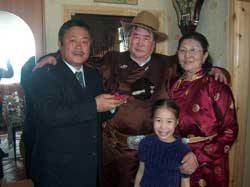
The home of Professor Sodnomdorj who was Nippon Kan’s first contact in Mongolia.
After the New Year holiday drew to a close and before his return to the US, Homma Kancho found the time to visit a morin huur factory, and a ger factory to discuss future importing projects. It was a hectic week with Homma Kancho in Mongolia, but the time spent was invaluable and rewarding for all. We look forward to Homma Kanchos next visit, hopefully later on this year.


